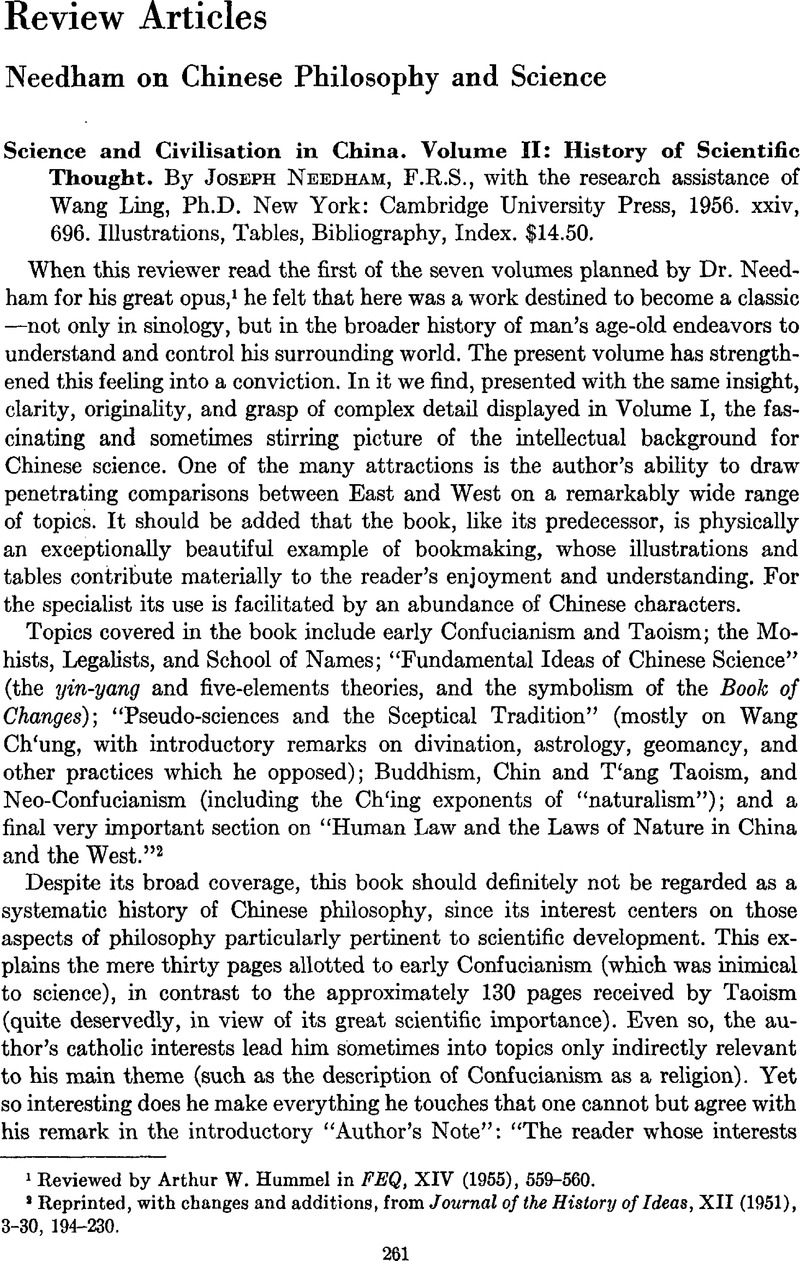No CrossRef data available.
Published online by Cambridge University Press: 23 March 2011

1 Reviewed by Hummel, Arthur W. in FEQ, XIV (1955), 559–560.Google Scholar
2 Reprinted, with changes and additions, from Journal of the History of Ideas, XII (1951), 3–30, 194–230.Google Scholar
3 Nor does the bibliography list the valuable study by Nivison, David S., “The Problem of ‘Knowledge’ and ‘Action’ in Chinese Thought since Wang Yang-ming,” in Studies in Chinese Thought, ed. Wright, Arthur F. (Chicago, 1953).Google Scholar
4 A suggestion along these lines was already made as early as 1856 by that astute student of Chinese thought, T. T. Meadows: ‘“To us it appears evident, that the whole tendency of philosophy, from the time of Leibnitz, has been to bring us nearer and nearer to a purely dynamical theory of the universe.’ … [here Meadows is quoting from J. D. Morell's Philosophy of Religion, N. Y., 1849Google Scholar] … There are some remarkable resemblances between that system [of Leibniz] and the Chinese theory … [instances cited] … Leibnitz busied himself with Chinese studies,—if my memory does not fail me, with Chinese philosophy. Can it be possible that he therein got the hint to the main features of his system, and that all German idealism started from the philosophical speculations of the Chinese!” See Meadows, Thomas Taylor, The Chinese and Their Rebellions (London, 1856), p. 371.Google Scholar
5 “They [the Taoists] went to the roots of science and democracy alike” (p. 59). “The Taoists were against the concepts of noble and mean as applied to Nature, but they were also against them as applied to Man, and thus they affirmed their science and their democracy at the same time” (p. 103). “It was probably no coincidence that Taoism in its ancient form was connected both with the earliest Chinese science and technology, and with the ideal of ancient equalitarian pre-feudal Chinese society” (p. 132).
6 “Essentially an anti-feudal force, they glided imperceptibly, when it more and more appeared that there could be no going back to their ideals, and that feudal bureaucratism was destined to be the characteristic form of Chinese society, into a heterodox religious mysticism” (p. 98).
7 For example, the Lao-tzu, Sec. 11, reads (in Waley's traditional interpretation): “We put thirty spokes together and call it a wheel; / But it is on the space where there is nothing (wu) that the utility of the wheel consists.” In Needham's translation, however, this becomes: “Thirty spokes combine to make a wheel; / When there was no private property (wu) carts were made for use.” (Italics in both translations mine.) Whereas the traditional interpretation makes excellent sense, I find in the new interpretation no meaningful connection between the wheel of thirty spokes and the absence of private property.
8 At first sight the correlation of black with water and the north (which Needham omits from his explanation) seems obscure, until we remember that water, as the opposite of fire among the elements, naturally goes with north (which is the opposite of south, the direction of fire), and that north is also the direction of the yin principle, whose characteristics include coldness, moistness, and darkness. It thus naturally follows that black ( = darkness) should be the color of water as well as of the yin.
9 “The five-element and Yin-Yang system is seen to have been not altogether unscientific” (p. 293). “The only trouble about the Chinese five-element theories was that they went on too long” (p. 294).
10 In this terminology, as in the case of Leibniz (see n. 4 above), there is a striking parallel between Needham and Meadows, who wrote a century earlier: “Le [li] also denotes a kind of principle of organization: the internal and essential form of Europeans.” See Meadows, , The Chinese and Their Rebellions, p. 350Google Scholar (italics in original).
11 Lu-shih ch'un-ch'iu, as quoted on p. 82: “If a man climbs a mountain, the oxen below look like sheep and the sheep like hedgehogs. Yet their real shape [meaning size? D. B.] is very different. It is a question of the observer's standpoint.” Hsün Tzu, as quoted on p. 26: “So when viewed from a mountain, a cow looks like a sheep (but whoever wants a sheep knows better than to go down and lead it away)—distance obscures size. Seen from the foot of a mountain, a sixty-foot tree looks like a chopstick (but whoever wants a chopstick knows better than to go up and break it off)—heights obscure lengths.” I do not know the reason for Needham's parentheses.
12 P. 578, after stating that Chinese mathematics was algebraic, Greek mathematics geometric: “Now there is something suspiciously similar between the abstractness of Euclidean geometry and the abstractness of Roman law. … But the Chinese preferred to think only of concrete numbers (though, as in algebra, they might not be any particular numbers). … ” P. 292, n. d: “At first sight geometry would seem to be the study of pattern par excellence. But algebra deals with pattern in a still more abstract way, not limiting it to dimensions in space or to particular numerical values.”